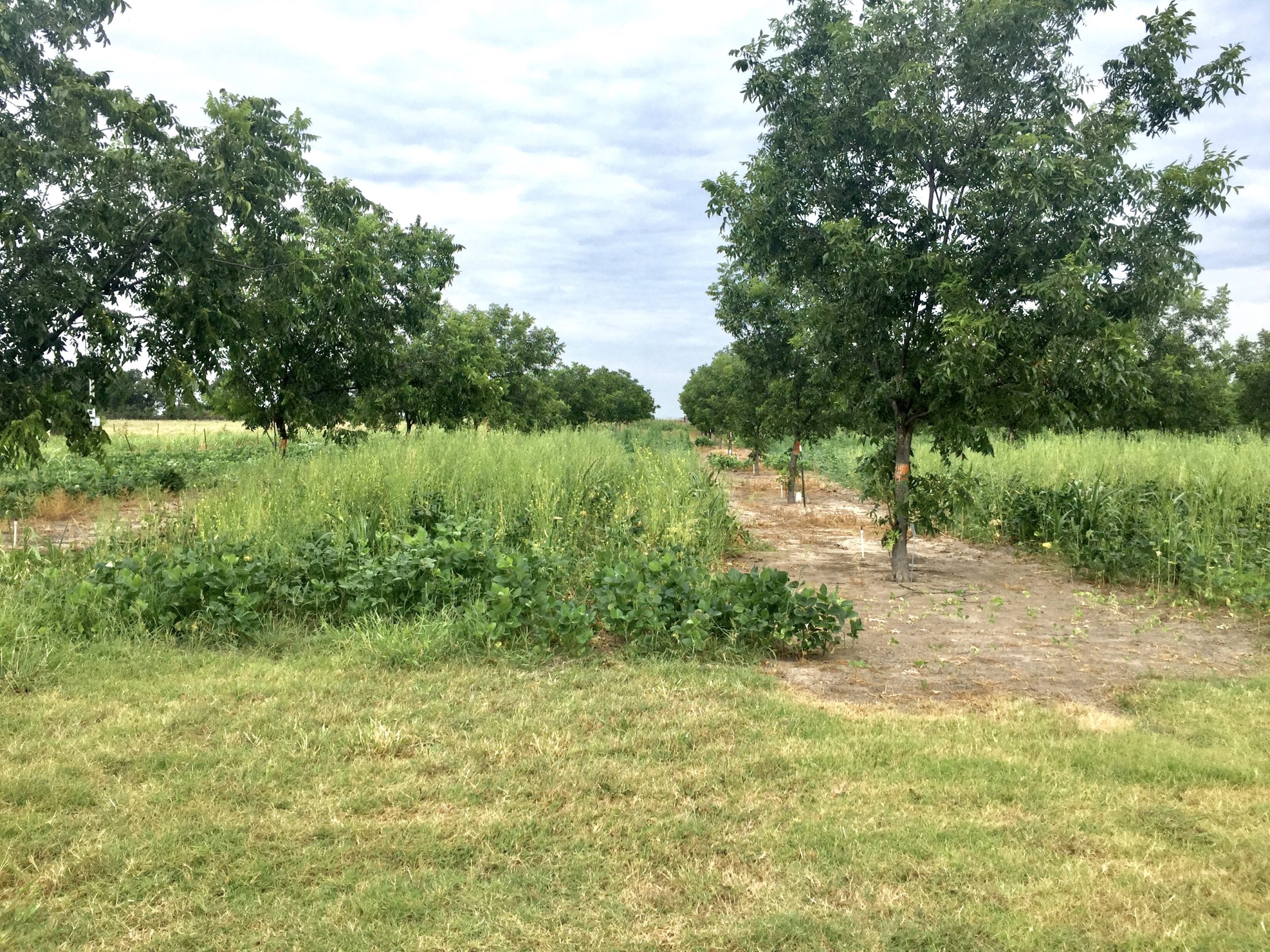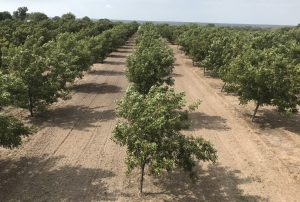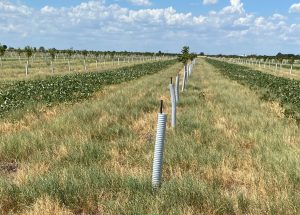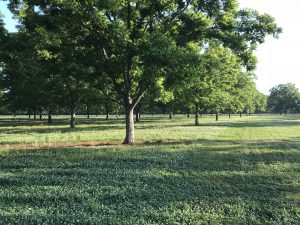Cover Crop Uses in Pecan Silvopasture

Cover crops planted in a pecan orchard to try and improve its soil health. While bringing benefits to the orchard itself, sustainable practices like this one also align with many consumers’ desires for more environmentally friendly products. (Photo by Charles Rohla, Noble Research Institute)
The idea of having ground cover growing in an orchard is a subject that has slowly evolved—from clean cultivation to having some kind of grass growing between the rows to support equipment used in the orchard, especially during wet conditions. The next step was incorporating nitrogen-fixing plants such as clovers and vetch into the orchards to supplement available nitrogen to the trees. But with the industry’s push into more sustainable and regenerative practices, we have seen an explosion in the use of cover crops to accomplish specific goals in improving the orchard or grove.
We should start by discussing how a cover crop is currently defined. In the simplest terms, cover crops are crops planted to cover the soil or possibly used as a forage instead of being harvested as a cash crop. In the context of row crops, a cover crop is commonly grown as a part of the crop rotation sequence during the fallow time between cash crops. However, in a silvopasture system, cover crops typically would provide erosion protection against water and wind events, provide forage for livestock or wildlife grazing, or supply supplemental nitrogen to the trees.
Many cover crop species exist. Species selection depends on when the species can be planted and what is the goal for its use. Soil erosion reduction is a primary goal attained. Legume species fix atmospheric nitrogen into a form that plants and microorganisms can use. Non-legume species recycle existing soil nitrogen and other nutrients and can reduce leaching losses. Cover crops are generally divided into two broad categories: Legumes and Non-legumes.
Legumes
Legume cover crops consist of winter annuals, winter perennials, biennials, and summer annuals. Their most common uses include nitrogen fixation, erosion remediation, biomass production to improve soil organic matter, and the ability to attract beneficial insects. Legume cover crops typically have a lower carbon-to-nitrogen ratio than grass cover crops. This lower carbon-to-nitrogen ratio results in their plant residues breaking down more rapidly than grass residues, which can be considered a plus since nutrients in the legume residues will be available to pecan trees sooner than nutrients bound in grass residues. But on the flip side, legume residues won’t suppress weeds as long as grass residues. As mentioned earlier, legumes (red clover, crimson clover, vetch, peas, beans) can fix a lot of nitrogen (N), generally ranging from 50 to 150 pounds per acre, depending on growing conditions. This supplemental nitrogen allows you to stop nitrogen applications in native pecan groves and significantly reduce nitrogen fertilizer applications in high-input improved pecan orchards. Because legumes have a wide range in nitrogen-fixing abilities and their adaptability to varying soil types and climates, you should confer with Extension personnel, seed distributors, and local growers on the best varieties to plant in your area.
Non-Legumes
Non-legume cover crops consist of annual cereals, annual or perennial forage grasses, warm-season grasses, brassicas and mustards, and other non-legume broadleafs. Non-legumes are most useful for scavenging nutrients, preventing erosion, suppressing weed by allelopathic and biomass production, and increasing soil organic matter. Their ability to scavenge nutrients is most important during the dormant season of a pecan orchard, especially for those using manure or other organic sources as fertilizers. Over the winter season, when the trees are dormant, non-legumes can capture in excess of 100 pounds of nutrients per acre. Because non-legumes have a higher carbon-to-nitrogen ratio than legumes, they are broken down more slowly by microbes, thus providing a long-lasting residual that serves as a slow-release nutrient source for pecan trees over the spring and summer months.
In a perennial system such as a pecan orchard, groundcover management is a year-round endeavor to help improve soil health, tree health, and nut crop quality. In this case, the cover crop should not be too competitive with the pecan trees, especially young trees. In a silvopasture scenario, the cover crop serves as a living mulch and must be able to withstand some shade, occasional traffic, periodic drought or flooding, and grazing by livestock/wildlife. An example of a naturally occurring cover crop commonly found in native pecan groves in the mid-South is Dutch white clover. It is persistent, requires little maintenance, provides good erosion protection, and provides some nitrogen for the pecan orchard.
However, no single cover crop can accomplish all of the roles needed in an orchard at a high level. So, it is important for you to prioritize your objectives each year for the benefits you are hoping to achieve by using a specific cover crop. All cover crops indeed provide some benefits, but some species do a better job than others on a particular task. Do I want to provide supplemental nitrogen using a plant that can fix atmospheric nitrogen? Do I have a soil compaction problem? Problems with erosion? Wanting to increase soil organic matter? Improve water infiltration? Suppress weeds? Provide livestock forage at a specific time of the year?
Do I have your attention now? Feeling overwhelmed? Let’s take a closer look at what cover crops can accomplish in your orchard if you choose the right cover crop type for the job.
Erosion prevention from wind and water events. This is easy if you are following the Soil Health Principles associated with growing pecan regeneratively. Keep the soil covered and minimize soil disturbance. A living plant will stabilize the soil and prevent soil movement; you have to ensure the soil is protected when erosion events occur. Select plants for cover crops with the physical characteristics necessary to provide adequate protection. Selecting an appropriate cover crop will reduce surface runoff, curtailing the loss of nutrient-laden sediments in the orchard. Some of the cover crops rated as very good at erosion control include Austrian winter pea, crimson and white clover, sunn hemp, oats, ryegrass, rapeseed, and mustard.
Soil compaction remediation. Compaction has always been a concern in pecan orchards. Whether the compaction is associated with equipment movement, livestock grazing, or pre-existing plow pans, it is possible to remediate it using selected cover crops. Soil tilth will be improved as plant roots grow into compacted areas, so cover crops that produce deep tap roots and/or have a large root biomass can aid in improving soil organic matter, soil structure, and water infiltration. You may see this referred to as biodrilling in some publications. Common cover crops that remediate soil compaction include sweet clovers, cereal rye, sorghum-sudangrass, daikon radish, oilseed radish, okra, and sunflower.
Increase soil organic matter content (biomass production). Improving the soil organic matter content should be a goal for every pecan grower. Its positive impacts on the soil water-holding capacity, nutrient-holding capacity, soil aggregation and structure, biological activity, and water/air infiltration cannot be over emphasized. Cover crops that have high aboveground biomass and/or root mass are best for maintaining and improving soil organic matter. Cover crops that can enhance soil organic matter include sweet clovers, sunn hemp, sorghum-sudangrass, cereal rye, and oats.
Capture and recycle, or redistribute nutrients in the soil profile. This is a broad topic, so we will break it down into more specific objectives. Let’s start with minimizing nitrogen leaching through the soil profile. This can be important if you are using manures as a fertilizer source or use a fall application of nitrogen during a heavy crop year. Cover crops can reduce nitrogen leaching by 50 to 95% compared to bare ground in wet and dry years. Good nitrogen-scavenging cover crops include ryegrass, oats, sorghum-sudangrass, winter wheat, rapeseed, and radish.
After an orchard has been established for a while, it is not uncommon for many pecan orchard soil samples to show high to very high levels of phosphorus and potassium. This is especially true for orchards with a history of manure use. A portion of this phosphorus and potassium becomes bound and is not available for pecan tree roots to absorb. Some will be lost to precipitation runoff and erosion, while part of these nutrients will be leached through the soil. There are several cover crops that are good at scavenging for these nutrients and recycling them for use by other plants. These cover crops include buckwheat, red clover, rye, winter wheat, mustard, and radish.
If you look back on our discussion on using deep-rooted cover crops to remediate compaction problems, those plants are also good for moving nutrients from the subsoil to the topsoil. These “bio-drillers” not only redistribute nutrients from deeper in the soil profile back to the surface layer, but the root channels left after they die are used by other crops to explore deeper into the soil profile. Good subsoiling cover crops include sorghum-sudangrass, radishes, sweet clovers, sunflower, chicory, and alfalfa.
Promote biological nitrogen fixation. As previously discussed, there are cool season and warm season legumes available for planting in pecan orchards. Cool season legumes would have the advantage of not competing directly with pecan trees for soil moisture for most of their life cycle (trees will be dormant). Cool season legumes would also be flowering in the spring, thus stimulating the population of beneficial insects early in the pecan growing season. An important consideration to remember about legumes: Do they need to be inoculated with the appropriate Rhizobium bacteria at planting, or does your soil have an existing population of Rhizobium? Legumes recommended for pecan orchards in Oklahoma include crimson clover, hairy vetch, red clover, and white clover.
Weed suppression. Cover crops can aid in weed suppression by producing allelopathic compounds that prevent seed germination or by rapid biomass production to suppress or smother weeds. This can occur while they are actively growing, or the crop residue left on the orchard floor provides both chemical (allelopathic compounds) and physical (mulching) weed suppression. Cover crops with good weed suppression characteristics include buckwheat, sunn hemp, ryegrass, oats, subterranean clover, and woollypod vetch.
Provide supplemental forage. Cover crops can not only provide food and habitat for wildlife, beneficial insects, and pollinators but can also be an important part of a livestock enterprise by providing quality forage for grazing. Selecting cover crops for grazing in a producing pecan orchard must take into account the windows available so that manure does not interfere with the harvest process in the fall. Common forages used include crimson clover, red clover, white clover, ryegrass, winter wheat, and sorghum-sudangrass.
While I have listed individual cover crops in each category, I am not suggesting that you plant monocultures in the orchard. Under each objective, you will generally find a mix of plant types (legumes, non-legumes, grasses, broadleafs, etc.) recommended to accomplish that objective. Yes, it is true that seeding cover crop mixes is more difficult than a single crop, and management can be more challenging, but the use of mixtures allows you to concentrate on one objective while still making small gains on others. Compared to pure stands of legumes or non-legumes, a mixture of cover crops will generally provide increased biomass and nutrient levels, improve ground coverage leading to better weed suppression, and improve tolerance to a broader range of environmental conditions. Mixtures will attract a more diverse population of beneficial insects and pollinators, as well as give you a greater assortment of forage options for livestock operations. Increased biodiversity above the ground will promote a greater diversity of microorganisms in the soil, which should improve nutrient availability and soil structure.




